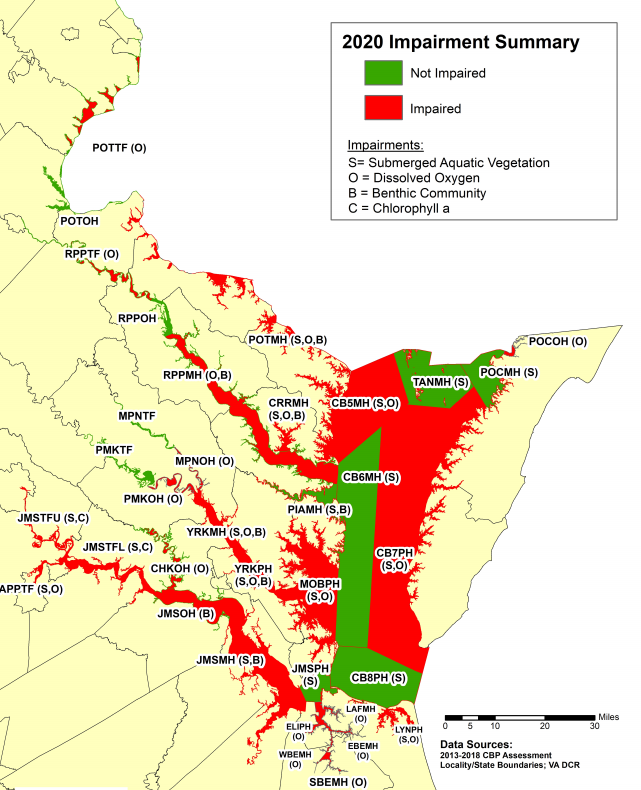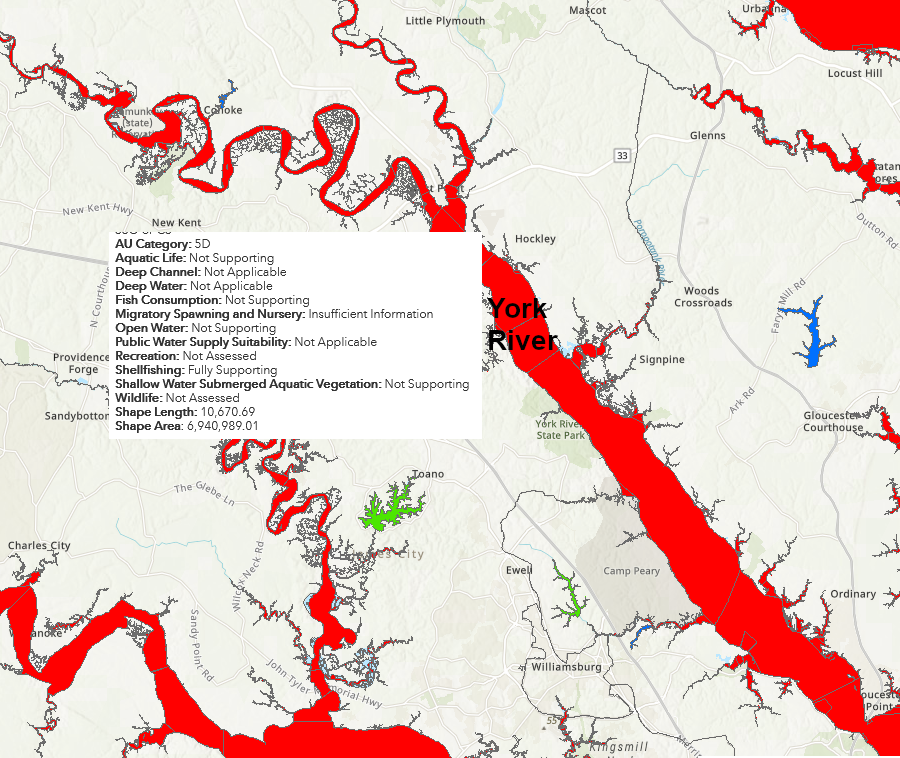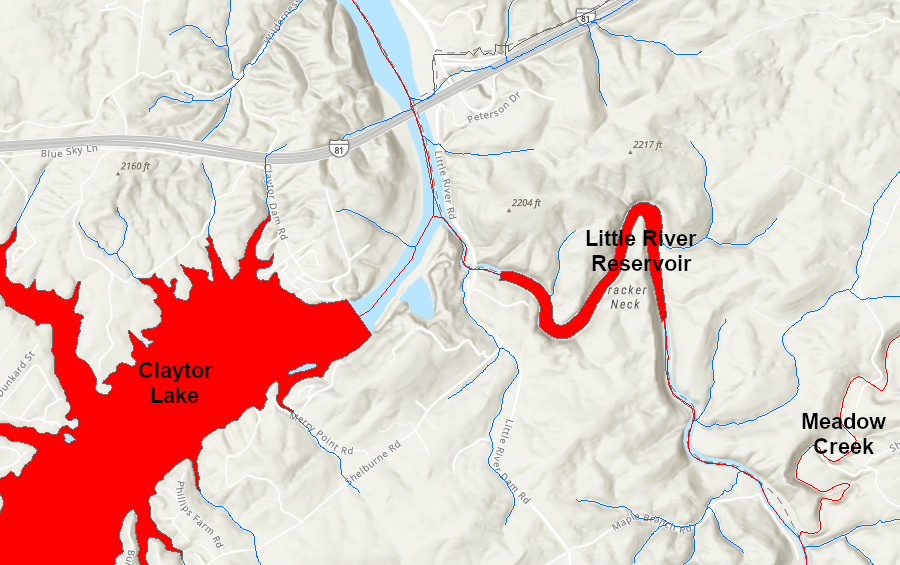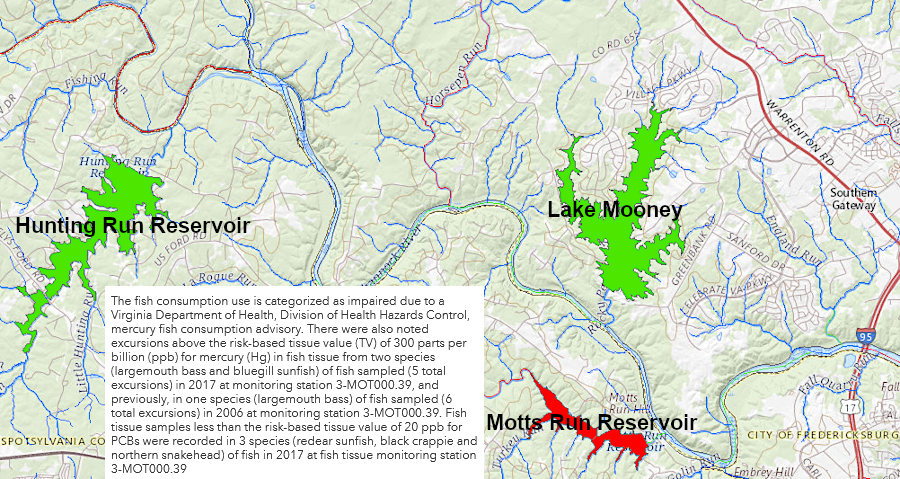"Dirty Water List" in Virginia

in 2020, some parts of the Chesapeake Bay were not impaired and thus were not included on the dirty waters list
Source: Virginia Department of Environmental Quality (DEQ), Summary of All Impairment Causes in Virginia's Bay Waters
Section 303(d) of the Clean Water Act requires each state to identify its impaired waters - those rivers, lakes and estuaries which do not meet the six primary designated uses. Every two years, the Virginia Department of Environmental Quality (DEQ) issues the 305(b)/303(d) Water Quality Assessment Integrated Report, known as the "Dirty Water List."
The six designated uses in Virginia against which water bodies are assessed:1
- Aquatic Life Use: supports the propagation, growth, and protection of a balanced indigenous population of aquatic life which may be expected to inhabit a waterbody. In Chesapeake Bay waters (mainstem and tributaries), this use is divided into sub-uses that target specific aquatic life assemblages
- Recreation Use: supports swimming, boating, and other water-contact recreational activities
- Fish Consumption Use: supports game and marketable fish species that are safe for human health
- Shellfishing Use: supports the propagation and marketability of shellfish (clams, oysters, and mussels)
- Public Water Supply Use: supports safe drinking water
- Wildlife Use: supports the propagation, growth, and protection of associated wildlife

multiple problems caused the main stem of the York River to be listed as impaired in 2020
Source: Virginia Department of Environmental Quality (DEQ), Environmental Data Mapper
The water monitoring strategy in Virginia is to assess one third of the state's 1,247 sub-watersheds every two years. That cycle results in each 12-digit (6th Order) sub-watershed being re-evaluated every six years. The Virginia Department of Environmental Quality (DEQ) includes a Total Maximum Daily Load (TMDL) Priority List for impaired waters in the biennial report to the Federal government.
The Environmental Protection Agency and the Virginia Department of Environmental Quality categorize rivers, lakes and estuaries that meet water quality standards for the six designated uses as Category 1 waters.
In Category 2 waters of the designated uses are supported, but data is inadequate to determine if all uses are supported. For example, if no water quality standard exists for a specific pollutant, then the waters are included in Category 2. If there is inadequate information to determine if any designated uses are met, the waters are placed in Category 3.
Category 4 waters are impaired or threatened, but a new TMDL is not required. The pollution that damages such waters is from natural sources, or is being addressed by actions other than a TMDL (such as requirements in a stormwater permit) that will correct the problem within two years. In addition, impaired tributaries to waters where the impairment is already being addressed by a previous TMDL are placed in Category 4 as well.
Category 5 waters are impaired or threatened by pollution that makes the stream, lake or estuary unsuitable for one or more designated uses, and require a TMDL to be developed.
Virginia has established more-detailed categories:2
- FULLY SUPPORTING - Waters are supporting one or more designated uses
- EPA Category 1 - Attaining all associated designated uses and no designated use is threatened
- • Va. Category 1A - waters are attaining all uses and a TMDL has been developed for one or more uses.
- EPA Category 2 - Available data and/or other information indicate that some, but not all of the designated uses are supported.
- • Va. Category 2A - waters are supporting all of the uses for which they are monitored.
- • Va. Category 2B - waters are of concern to the state but no water quality standard exists for a specific pollutant, or the water exceeds a state screening value or toxicity test.
- • Va. Category 2C - waters are now attaining the use(s) for which they were originally 303(d) listed and the TMDL is EPA approved but other applicable use(s) were not monitored and assessed.
- INDETERMINATE - Waters needing additional information
- EPA Category 3 - Insufficient data and/or information to determine whether any designated uses are met.
- • Va. Category 3A - no data are available within the data window of the current assessment to determine if any designated use is attained and the water was not previously listed as impaired.
- • Va. Category 3B - some data exist but are insufficient to determine support of designated uses. Such waters will be prioritized for follow-up monitoring, as resources allow.
- • Va. Category 3C - data collected by a citizen monitoring or another organization indicating water quality problems may exist but the methodology and/or data quality has not been approved for a determination of support of designated use(s). These waters are considered as having insufficient data with observed effects. Such waters will be prioritized by DEQ for follow-up monitoring.
- • Va. Category 3D - data collected by a citizen monitoring or other organization indicating designated use(s) are being attained but the methodology and/or data quality has not been approved for such a determination.
- IMPAIRED - Waters are impaired or threatened but a TMDL is not required.
- EPA Category 4A - water is impaired or threatened for one or more designated uses but does not require a TMDL. A new TMDL is not necessary to address the newly identified impaired tributaries if TMDL modeling, source identification and reductions cover the entire watershed and the TMDL has been approved by EPA. These waters are primarily related to shellfish and/or recreational bacteria impairments but could include benthic impairments.
- EPA Category 4B - water is impaired or threatened for one or more designated uses but does not require the development of a TMDL because other pollution control requirements (such as VPDES limits under a compliance schedule) are reasonably expected to result in attainment of water quality standards by the next reporting period or permit cycle.
- EPA Category 4C - water is impaired or threatened for one or more designated uses but does not require a TMDL because the impairment is not caused by a pollutant and/or is determined to be caused by natural conditions.
- • Va. Category 4D - part(s) of a water quality standard is attained for a pollutant with a TMDL, but the remaining criteria for the standard were not assessed due to insufficient information. (Only to be applied to dissolved oxygen in tidal waters of the Chesapeake Bay).
- IMPAIRED - Waters are impaired or threatened and require a TMDL
- EPA Category 5 - Waters are impaired or threatened and a TMDL is needed.
- • Va. Category 5A - a water quality standard is not attained. The water is impaired or threatened for one or more designated uses (excluding shellfish use) by a pollutant(s) and requires a TMDL (303d list).
- • Va. Category 5B - the water quality standard for shellfish use is not attained. One or more pollutants causing impairment require TMDL development.
- • Va. Category 5C - the water quality standard is not attained due to “suspected” natural conditions. The water is impaired for one or more designated uses by a pollutant(s) and may require a TMDL (303d list). Water quality standards for these waters may be re-evaluated due to the presence of natural conditions.
- • Va. Category 5D - the water quality standard is not attained where TMDLs for a pollutant(s) have been developed but one or more pollutants are still causing impairment requiring additional TMDL development.
- • Va. Category 5F - the water quality standard is attained for a pollutant(s) with a TMDL and 303(d) delisting approved but the water remains impaired for additional pollutant(s) requiring TMDL development.
- • Va. Category 5R - the Water Quality Standard is not attained and the water is impaired, and implementation of an EPA-accepted restoration plan is expected to result in attainment. A status update will be provided each 303(d) cycle to evaluate progress.
- EPA Category 5M - the water quality standard is not attained for mercury primarily due to atmospheric deposition.

Little River and its tributaries are impaired due to E. coli, while Claytor Lake is impaired due to dissolved oxygen and PCBs in fish tissue
Source: Virginia Department of Environmental Quality (DEQ), Environmental Data Mapper
Links
- Chesapeake Bay Program
- Virginia Department of Environmental Quality (DEQ)

Motts Reservoir was impaired due to aerial deposiion of mercury, while two nearby reservoirs were not listed in 2020
Source: Virginia Department of Environmental Quality (DEQ), Environmental Data Mapper
References
1. "2020 305(b)/303(d) Water Quality Assessment Integrated Report - Introduction," Virginia Department of Environmental Quality (DEQ), 2022, pp.2-3, https://www.deq.virginia.gov/our-programs/water/water-quality/assessments/integrated-report (last checked June 8, 2023)
1. "2020 305(b)/303(d) Water Quality Assessment Integrated Report - Introduction," Virginia Department of Environmental Quality (DEQ), 2022, pp.3-5, https://www.deq.virginia.gov/our-programs/water/water-quality/assessments/integrated-report (last checked June 8, 2023)
Waste Management in Virginia
Rivers and Watersheds of Virginia
Virginia Places




